| Introduction |
We devote this Podcaster to updates from all of the N2Africa PhDs. Some of the candidates started their studies during the first phase of N2Africa and are close to completion. Others just started their research last September and are still setting up their initial experiments and finalizing their proposals. The topics range from molecular studies with rhizobium to field agronomy, adoption studies and nutrition. We felt it was time for the next generation of nitrogen fixation researchers to share some of the excitement of their findings with you. I think you’ll agree that George Mwenda wins first prize for the incredibly beautiful photos of nodules shown below on this page!
We close with a couple of news items including a new collaboration within the EU with other research institutions. The next issue of the Podcaster will focus on public-private partnerships within N2Africa – so please send in your stories straight away.
Ken Giller
|
1 |
| Evaluation of competitiveness for nodulation of Phaseolus vulgaris L. in Kenyan rhizobial strains |
|
Beans nodulate promiscuously with rhizobia. The lack of specificity may be advantageous in certain circumstances but it generally poses a challenge to attempts to successfully inoculate beans. The inoculant strain, when applied, has to compete with indigenous strains for root infection sites and outcomes are dependent on numerous variables. In addition to identifying rhizobia nodulating beans in Kenya and assessing their nitrogen fixing potential, my research has used a dual marker system to study the competitiveness of indigenous strains against the major commercial inoculant strain, Rhizobium tropici CIAT 899. ...
|
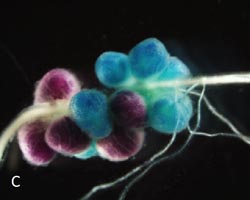 |
|
2 |
| Progress Report on PhD Studies Aliyu Anchau; Topic: Exploring the Genetic Diversity of Groundnut-nodulating Rhizobia in Moist and Dry Savannas of Nigeria for increased Symbiotic Nitrogen Fixation and Productivity |
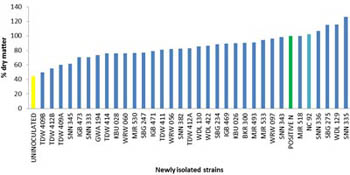 |
Aliyu Anchau, Abdullahi enrolled for his PhD studies in February, 2013 on the above topic. Arachis hypogaea L. root nodules were initially sampled from uninoculated plants in over ninety (90) farmers’ fields from the Northern Guinea and Sudan savannas of Nigeria during the 2013/2014 growing season.
Figure: Percent dry weight accumulated by SAMNUT 24 groundnut genotype with the newly isolated Nigerian indigenous rhizobia strains in relation to the positive N control (10 g L-1 N applied as KNO3)
|
|
3 |
| Genetic and Symbiotic Effectiveness of Indigenous Rhizobial Strains and Strategies to Maximize the Contribution of Biological Nitrogen Fixation on Soyabean in Mozambique |
| Amaral Machaculeha Chibeba started his N2Africa PhD project in August 2012 at Londrina State University in Brazil. In summary, he characterized rhizobia isolated from field-grown soyabean nodules brought from Mozambique, conducted field trials for testing symbiotic effectiveness of elite Bradyrhizobium strains on soyabean in Brazil and Mozambique and conducted a greenhouse experiment to evaluate the effect of co-inoculation of soyabean with Bradyrhizobium and Azospirillum (a plant growth promoting rhizobacterium) on the earliness (precocity) of nodulation. ... |
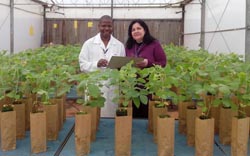 |
|
4 |
| Does the interaction of the indigenous and exotic rhizobia in contrasting Zimbabwean soil conditions result in superior isolates worthy of the inoculant strain title? |
 |
Mazvita Chiduwa is pursuing her studies for a PhD at Murdoch University. She commenced in July 2012 under the supervision of Ravi Tiwari, John Howieson, Julie Ardley, Graham O’Hara and Paul Mapfumo.
Soyabean is grown throughout Zimbabwe and is recognised as a strategic crop because of the myriad of benefits accruing. Although indigenous rhizobia have been isolated, distribution is highly erratic and inoculation is critical to obtain economic yields in Zimbabwe. ...
|
|
5 |
| Impact of Improved Cowpea Technology on Women Farmers in Southern Borno State, Nigeria. |
This research is on cowpea (Vigna unguiculata, (L.)) which is an annual leguminous crop indigenous to Tropical Africa. Women farmers mostly grow cowpea as a food security crop and it is an important source of protein and income for many of them. The high protein content of cowpea, its adaptability to different types of soils, drought tolerance, ability to improve soil fertility and prevention of soil erosion makes it an important economic crop. In Africa, the women farmers produce, process and sell snacks made from this nutritious legume. With a growing market for cowpeas both within and outside the country, women can be encouraged to increase their production by using improved cowpea technology.
|
6 |
| Studying the benefits of intensifying common bean cultivation on smallholder farms in the Northern Highlands of Tanzania |
|
Intensification of common bean (Phaseolus vulgaris L.) cultivation on smallholder farms in the Northern Highlands of Tanzania is the main focus of my PhD study. This study is prompted by the low yields (0.3 – 1 t ha-1) obtained by smallholder farmers, despite the large prospective productivity of improved varieties of common bean (3 t ha-1) in Tanzania. The study aims to unravel the contributions of genetic, management and environment related factors to common bean yield and nitrogen fixation. It also includes cultural, social and economic analyses of growing common beans. ...
|
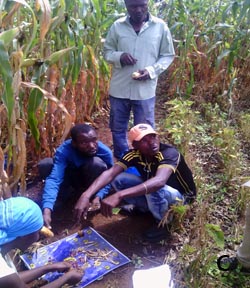 |
|
7 |
| Update on PhD research – Adoption and adaptation of improved climbing bean technologies in Uganda |
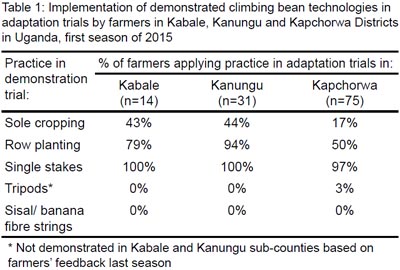 |
Esther Ronner is research assistant employed by N2Africa at Wageningen University and is conducting her PhD studies within the project.
In June, two students from Makerere University (Florence Ajio and Ezakiel Muranda) started the collection of data among farmers with climbing bean adaptation trials in eastern Uganda (Kapchorwa District) and southwestern Uganda (Kabale and Kanungu Districts). The two students are doing an internship in the context of my PhD research on the adoption and adaptation of improved climbing bean technologies in Uganda. The students use the ‘field book for adaptation trials’, but work with additional questions on the cultivation of climbing beans including staking methods, materials, densities, length, etc. ...
|
|
8 |
| Legume genotypes x rhizobium strains interaction in common bean and chickpea |
| An update on the objective (To screen effective, competitive and host broad spectrum of common bean and chickpea rhizobia for use in African soils) and main activities and methods to achieve the objective and results so far from Ashenafi Hailu Gunnabo |
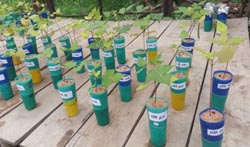 |
|
9 |
| Nigerian PhD Research update |
 |
I am Ojo Comfort Tinuade, one of the N2Africa PhD rstudents with Wageningen University and a Research Fellow with International Institute of Tropical Agriculture, Ibadan. My research interest is to explore the potential benefits of rhizobia inoculation with cowpea. My research activities includes estimating the population density of indigenous rhizobia in soil samples collected from Northern Nigeria, isolation and identification of highly competitive and efficient rhizobia strains from Nigerian soils.
|
|
10 |
| Exploring options to enhance biological nitrogen fixation and yield of soyabean and common bean in smallholder farming systems of Rwanda |
|
In Rwanda like in many sub-Saharan Africa countries, increasing population hence reduction of farm size, declining soil fertility and high fertilizer cost have been reported as major production constraints for smallholder farmers. The use of organic inputs and biological nitrogen fixation are alternative to cut down fertilizer costs. Rwandan government has recently set a policy of one cow per poor family in one hand to deal with soil fertility issues. In this study we explored the benefits of using manure and inoculation for increased nitrogen fixation and yields of bean and soyabean, and manure showed the ability to sustain productivity without repeated inoculation. ...
|
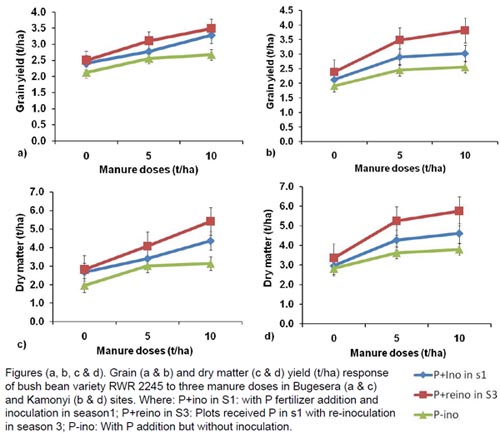 |
|
11 |
| Effect of intercropping patterns on crop productivity across fields of different soil fertility in northern Guinea and Sudan savannah agroecological zones of Ghana |
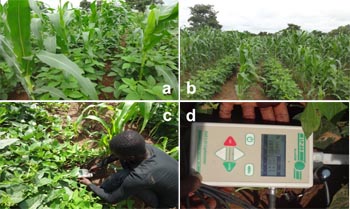 |
Two on-farm trials were conducted in the 2013 and 2014 cropping seasons in the northern Guinea savannah agroecological zone (AEZ 1) and the Sudan savannah agroecological zone (AEZ 2) of Ghana to evaluate the effect of intercropping patterns and the effect of cowpea-maize relay intercropping on crop productivity. The intercropping patters were within-row intercropping and 1:1 and 2:2 distinct rows of maize- legume (Figure 1a, b). The legumes tested included cowpea, soyabean and groundnut. The trials were conducted across fields of different soil fertility levels. In this article, radiation interception and land equivalent ratios of the different intercropping systems are discussed. ...
|
|
12 |
| Common bean and response to rhizobial strains on different soil types in Uganda |
|
Common bean (Phaseolus vulgaris L.) is one of the most important grain legumes in Uganda. It forms an important part of the traditional diet and provides a good source of income for the rural communities. Experiments with rhizobial inoculation on beans in East Africa have met with varying success. One possible explanation is that common bean can establish effective symbiosis with broad range of native rhizobia. The role of this so-called promiscuity in the irregular response to inoculation remains to be established. It is currently not known how the composition of the rhizobial population in soil affects nitrogen fixation in common bean. ...
|
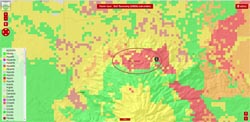
ISRIC soil maps for Kapchorwa
|
|
13 |
| Grain legume residues as a livestock feed resource for smallholders in northern Ghana |
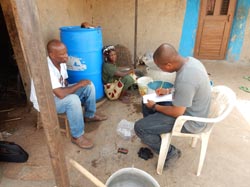 |
Agriculture in Ghana is dominated by small-scale crop-livestock farming based on cereal and legume production and livestock rearing. Livestock rearing is an important component of crop-livestock farming system because it serves as an insurance against crop failure, a source of manure, a source of cash and makes good use of crop residues. The main objective of this study is to understand the roles and functions of grain legume residues in livestock farming systems and identify options to improve utilisation by smallholders in northern Ghana. ...
Figure: Individual interview with a female farmer at Sandu Community, Northern region
|
|
14 |
| Crowdsourcing for agricultural data collection |
|
Data availability often limits detailed assessment and explanation of yield gaps at farm level. Bottom-up data collection approaches (e.g. crowdsourcing) can be used to overcome lack of data and improve yield gap analysis. A case study with 50 farmers selected from 5 districts was carried out in Ethiopia. The main objective of the case study was to explore the opportunities and applicability of innovative bottom-up data collection approaches like crowdsourcing (using SMS) and digital devices (tablets) to collect factors that could explain yield gap. Detailed socio-economic and agronomic data were collected using tablets. Besides, short message system (SMS) using farmers owned basic phones was tested to assess its applicability to collect cropping and event calendar information (e.g. sowing date, weeding date) and incidence of pest and diseases directly from farmers. ...
|
 |
|
15 |
| What about N2Africa and the diet of this 2 year old Ghanaian girl Talata*? An update of my PhD research |
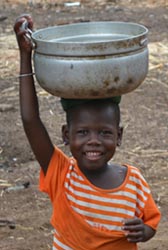 |
How are N2Africa activities linked with the dietary intake of infants and young children like this Ghanaian girl Talata? And how do the activities trickle down to the nutritional status of these infants and children and therefore their productivity later in life? The majority of the undernourished population in the world live in rural households in developing countries. Farming is their mainstay and often the only means to access of food and income. Evidence for theoretically assumed linkages between agriculture and nutrition is, however, weak. In the context of the N2Africa project, we will research the linkages between agricuture and nutrition and their drivers in rural households. ...
|
|
16 |
| Introducing Mr Shakiru Quadri, Youth Agri-preneur Facilitator for N2Africa-Borno State |
|
We have the pleasure of introducing Mr Shakiru Quadri, the Youth Agri-preneur Facilitator for N2Africa-Borno State, working under the supervision of Dr. Nkeki Kamai. Mr. Quadri is a graduate of General Agriculture of the Institute of Agricultural Research and Training (IAR&T), University of Ife (1982) with a first research work on "the effect of four rhizobium strains [local and foreign] on nodulation, N-fixation, and yield of cowpea [Ife brown]". He obtained a Master’s Degree in Business Administration (MBA) from the University of Ilorin (2005), and a Master of Science (MSc) Food Security and Development of the University of Reading, United Kingdom (2014).
|
 |
|
17 |
| N2Africa features as case study within the PROIntensAfrica project |
N2Africa was recently selected as case study within a project called PROIntensAfrica. PROIntensAfrica aims to build a long-term research and innovation partnership between Africa and the European Union, focusing on the improvement of food and nutrition security. The project has a large number of partners in Europe (including Wageningen University and CIRAD), and in Africa (including FARA, CORAF, CCARDESA, ASARECA). ...
|
18 |
| Other newsletters |
We received the Soybean Innovation Lab (SIL) July Newsletter.
|
19 |
















